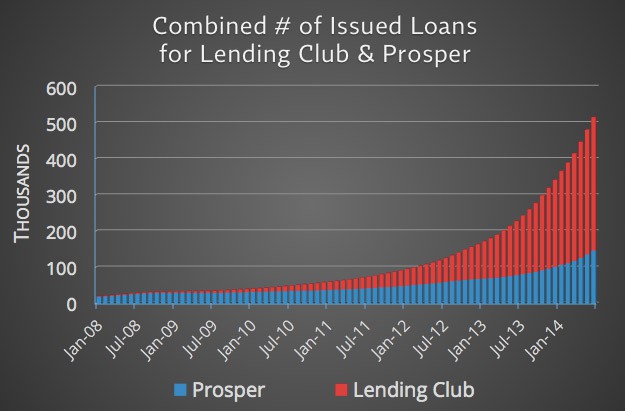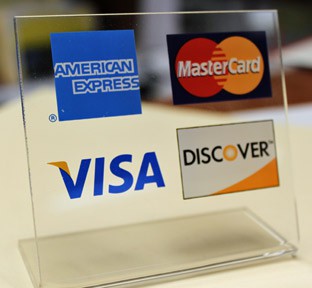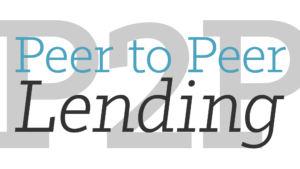These days, midway through 2014, peer to peer lending continues to ride a sensational rate of growth. It took Lending Club five years to cross $1 billion in issued loans. In contrast, $1 billion in loans were issued this past April-June alone. Prosper issued about a third of that volume during the same quarter ($369 million), no small feat. And this growth shows no sign of stopping.
Within the excitement, it can be valuable to take a step back from the hubbub and reflect on why this is a good thing to begin with. The most obvious benefit is the consistent yield it offers. As I’ve described before (Read: Why P2P Lending is Amazing), this is the first time in history that everyday Americans have access to the stable and lucrative returns of consumer credit, a 5-9% return for diversified peer to peer investors. This fact alone is remarkable, and reason enough for many to get involved.
Half a Million (!) Issued Peer to Peer Loans
At the same time, I would like to offer that something more meaningful is going on here, a facet sometimes forgotten by investors only focused on returns. The fact is, peer to peer lending is helping hundreds of thousands of people throughout the nation with their debt, as seen in the chart of total loans below:

Over half a million loans have been issued by Lending Club and Prosper, and 80% of these were used to consolidate burdensome debt. This chart is an amazing reminder that we as investors are earning a solid return by offering borrowers a more reasonable container for the debt they carry, and I’m not sure the investor community is always aware of how significant this is to people, aware of how much a lighter debt instrument can improve a borrower’s quality of life.
The Effects of Poorly Issued Debt
 The reality is, burdensome debt is a terrible thing, perhaps one of the worst. In my opinion, stacked against the more acute societal ills in our world today, heavy debt is second only to things like alcoholism.
The reality is, burdensome debt is a terrible thing, perhaps one of the worst. In my opinion, stacked against the more acute societal ills in our world today, heavy debt is second only to things like alcoholism.
This article from the New York Times emphasizes this well, highlighting thousands of farmers in India who have committed suicide. Basically, these farmers take out loans to plant crops. But if the crops fail, these over-leveraged farmers are often unable to pay the debt back, and the burden of repayment is so harsh that they take their own lives.
This is a systemic problem for India:
“In the Vidarbha cotton belt, which stretches across central India, to the eastern part of the state of Maharashtra, 451 cotton farmers have killed themselves since the beginning of this harvest; about 2,300 have committed suicide since 2000. Of the 3.4 million cotton farmers in this region, 95 percent are believed to be struggling with heavy debt.”
Or consider this poignant piece from the BBC that reports about how people in Bangladesh can be under such tremendous strain from their loans that they elect to sell their organs in the (misplaced) hope for debt relief:
“Because they cannot repay the loans, there is only one way for people to get out and that is to sell their kidney.”
These articles, though about societies poorer than the United States, do communicate an important point, which is how weighty debt can be upon the lives of the people who carry it. These breadwinners aren’t swallowing pesticides or selling their extra kidney because of some bizarre religious or cultural conviction. No, they are simply struggling beneath their loans.
The Two Characteristics of Poorly Issued Credit
Further, these stories show us how not to issue credit to people; ergo, if a portion of your borrowers are selling their kidneys to make their payments, something is probably wrong with the way you are handing out your loans.
In this regard, I would like to offer two ways that credit is poorly issued:
- Loans are given to people who are unlikely to repay them
- People are given loans that are difficult to repay
Bad-practice #1 is really about underwriting. Credit becomes burdensome when it is poorly underwritten – when the people who issue the loans do not adequately assess the creditworthiness of the borrower and thus give a lot of loans to people who will struggle and wilt under the loan’s responsibility.
A good measure of this is the lender’s aggregate rate of default. If a lender is issuing lots of loans, and a large portion of the borrowers go on to default (despite all the prearranged repercussions), both the investors and the borrowers are going to suffer. Not only have the loans gained volatility and a potentially negative return for their investors, but large cross-sections of the borrowers are experiencing the legal and emotional turmoil involved with failing to follow through on their commitment.
Bad-practice #2 is more about the terms of the debt instrument itself. Loans with exorbitant interest rates, loans that punish late-paying borrowers with harsh fees and unnerving variable interest rates, loans that penalize those who wish to pay them back early, are all devices that issuers can use to generate extra revenue. But not only are the lives of the borrowers made significantly worse by these harsh terms, over-reliance upon them indicates that the people issuing the loans have, again, a volatile investment on their hands.
The United States and our Credit Cards
 An example of poorly issued debt within the United States has been (surprise, surprise) the way Americans issue and use their credit cards. To summarize our national condition, Americans carry $11.4 trillion in total credit card debt, which comes out to an average of $15,000 per borrower (Debt.org).
An example of poorly issued debt within the United States has been (surprise, surprise) the way Americans issue and use their credit cards. To summarize our national condition, Americans carry $11.4 trillion in total credit card debt, which comes out to an average of $15,000 per borrower (Debt.org).
Speaking to bad-practice #1 above, many of these credit cards were issued through the lax underwriting of the past decades, so lines of credit were given to people who should not have been approved for them in the first place. Speaking to bad-practice #2, these were revolving lines of credit with variable interest rates of around 15%, which any financial planner will tell you is a pretty poor way to hold on to long-term debt.
Unfortunately, a long-term debt vehicle is what millions of people wanted. So lots of them went into debt who were unable to pay it back, the terms of the debt they took on being incongruent with the way it would be used. The result of this poor match-up was a downward spiral into debt for millions of individual Americans, and a collective degradation of our quality of life as a country.
Indeed, struggling under debt negatively touches every part of person’s life. A parent in deep debt is less able to be a good parent, less able to take time to help their child with homework or attend their school play. A friend in debt is less able to be a present, relaxed friend; a spouse in debt, a less dependable partner.
Saying this plainly in an internet article can come across flat, but if anybody has watched a friend or loved one drowning beneath credit card debt, they know the gravity of this condition. When the focus of someone’s week is completely bent on satisfying creditors, especially if income is already tight, the overall cell of that person and their family can become uncentered. Every aspect of life is made worse.
The Two Characteristics of Excellently Issued Credit
Just as bad loans are characterized by poor underwriting and callous terms, so good loans are properly underwritten alongside fair terms, and this is where our current practice of peer to peer lending shines.
#1. Peer to peer lending has precise underwriting
 Unlike credit issuers in the above stories from India or Bangladesh, Lending Club and Prosper have fine-tuned a complex algorithm over the years so as to only issue credit to those who can handle it (defaults around 4%). These platforms only make money on repayments if borrowers stay current on their loans, so they are focused on keeping their default rates as low as possible. The result of this push for lower defaults is a better investment for their lenders, as well as a smaller group of borrowers who are burdened by loans they are unable to repay.
Unlike credit issuers in the above stories from India or Bangladesh, Lending Club and Prosper have fine-tuned a complex algorithm over the years so as to only issue credit to those who can handle it (defaults around 4%). These platforms only make money on repayments if borrowers stay current on their loans, so they are focused on keeping their default rates as low as possible. The result of this push for lower defaults is a better investment for their lenders, as well as a smaller group of borrowers who are burdened by loans they are unable to repay.
#2. Peer to peer loans are fair to borrowers
Equally notable, peer to peer loans have some of the most reasonable loan terms in the United States. Since they have such low overhead from operating completely online, peer to peer lenders have lower interest rates than anywhere else, and this goes miles in reducing stress during a borrower’s repayment. Furthermore, peer to peer loans have a fixed term and no prepayment penalty. The money can only flow one way, so a borrower can never be tempted to go further into debt. The result is a future payoff date that promises a time when each borrower will be debt free, plus the ability to pay the loan off early without a fee.
Why Peer to Peer Lending is Beautiful
What is the result of all these low interest rate loans given to people who are likely to pay them off? It’s half a million creditworthy Americans who have consolidated their high-interest debt at a more reasonable rate and under more flexible terms. I emailed Lending Club CEO Renaud Laplanche for a metric to emphasize this point. He told me that the average borrower at Lending Club lowers their cost of credit by 29%.
What does it look like when the lives of half a million Americans become 30% lighter? Probably something like this:

- Truck drivers able to spend more time at home with their families
- Dating couples able to spend more quality time together
- Moms able to attend parent-teacher conferences
- Elderly people able to stop cutting pills in half
- Cashiers able to attend community college
- More money donated to charity
- Thicker relationships
- More time for kids
- More health
- Less stress
- Better lives
The word I keep seeing in the list above is able. People able to do more. Ability. Liberty. Freedom.
And this is why I believe is peer to peer lending is beautiful – not just for the way it is making my retirement more of a sure thing, enabling me to spend more time with my future grandchildren, but for the way it is setting thousands of borrowers free.
After all, it is one thing to give more liberty to investors who already possess some degree of it. But a far more significant thing is when an innovation like peer to peer lending shows up with the potential to release a massive cross-section of our country from the burden of debt altogether.
[image credit: skyseeker “parent and child”
vincent desjardins “Farmer”
PTMoney.com “Credit Card Issuers”
Philippe Put “marie stien” CC-BY 2.0]

I thought this was a great article and related to this blog entry:
“Which Type of Peer to Peer Lending Investor Are You?” via Stu Lustman
http://p2plendingexpert.com/which-type-of-peer-to-peer-lending-investor-are-you-im-3/
Definitely. Thanks Scott.
Beautiful article covering a beautiful space. Well done, Simon.
Thanks Blake
Hello, I have been reading up on P2P loans and I am trying to find someone who would be willing to assist me with a loan. I am hoping you could point me in the right direction. I tried applying for prosper but did not meet the guidelines. I was wondering if anyone knows of any peer to peer loans that pull from equifax and not experian? I am is process of still fixing my experian account which shows a score of 562, but my equifax is fine and my score is 696. No over due or late payments, steady income, but the report not being completed yet is causing an issue. Thanks
Great article Simon. Keep it up.